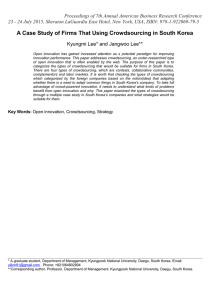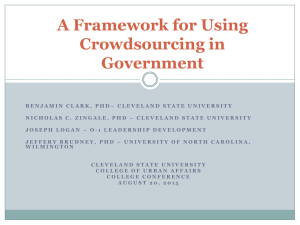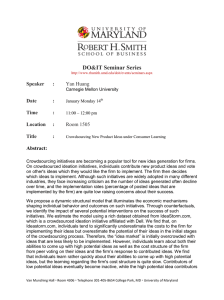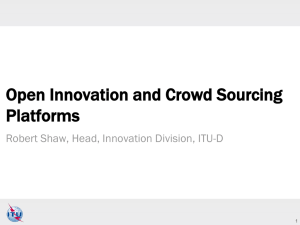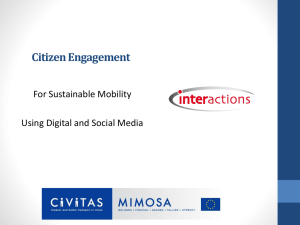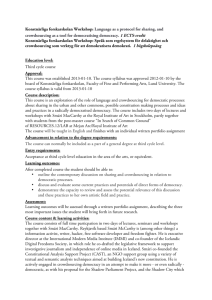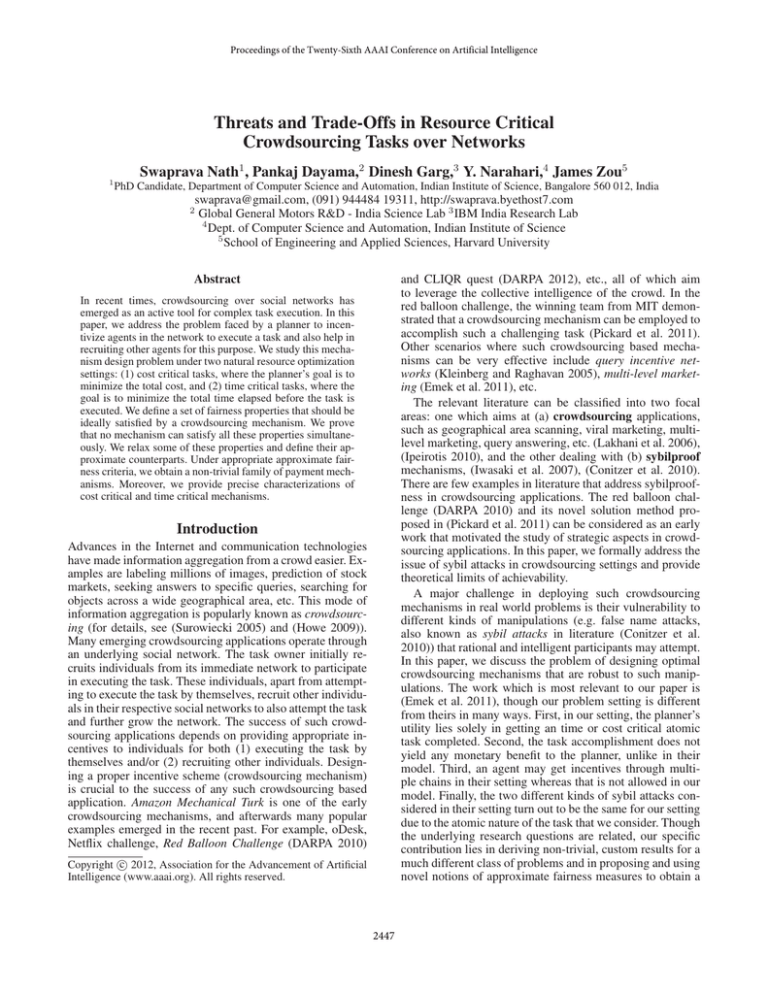
Proceedings of the Twenty-Sixth AAAI Conference on Artificial Intelligence
Threats and Trade-Offs in Resource Critical
Crowdsourcing Tasks over Networks
Swaprava Nath1 , Pankaj Dayama,2 Dinesh Garg,3 Y. Narahari,4 James Zou5
1
PhD Candidate, Department of Computer Science and Automation, Indian Institute of Science, Bangalore 560 012, India
swaprava@gmail.com, (091) 944484 19311, http://swaprava.byethost7.com
Global General Motors R&D - India Science Lab 3 IBM India Research Lab
4
Dept. of Computer Science and Automation, Indian Institute of Science
5
School of Engineering and Applied Sciences, Harvard University
2
Abstract
and CLIQR quest (DARPA 2012), etc., all of which aim
to leverage the collective intelligence of the crowd. In the
red balloon challenge, the winning team from MIT demonstrated that a crowdsourcing mechanism can be employed to
accomplish such a challenging task (Pickard et al. 2011).
Other scenarios where such crowdsourcing based mechanisms can be very effective include query incentive networks (Kleinberg and Raghavan 2005), multi-level marketing (Emek et al. 2011), etc.
The relevant literature can be classified into two focal
areas: one which aims at (a) crowdsourcing applications,
such as geographical area scanning, viral marketing, multilevel marketing, query answering, etc. (Lakhani et al. 2006),
(Ipeirotis 2010), and the other dealing with (b) sybilproof
mechanisms, (Iwasaki et al. 2007), (Conitzer et al. 2010).
There are few examples in literature that address sybilproofness in crowdsourcing applications. The red balloon challenge (DARPA 2010) and its novel solution method proposed in (Pickard et al. 2011) can be considered as an early
work that motivated the study of strategic aspects in crowdsourcing applications. In this paper, we formally address the
issue of sybil attacks in crowdsourcing settings and provide
theoretical limits of achievability.
A major challenge in deploying such crowdsourcing
mechanisms in real world problems is their vulnerability to
different kinds of manipulations (e.g. false name attacks,
also known as sybil attacks in literature (Conitzer et al.
2010)) that rational and intelligent participants may attempt.
In this paper, we discuss the problem of designing optimal
crowdsourcing mechanisms that are robust to such manipulations. The work which is most relevant to our paper is
(Emek et al. 2011), though our problem setting is different
from theirs in many ways. First, in our setting, the planner’s
utility lies solely in getting an time or cost critical atomic
task completed. Second, the task accomplishment does not
yield any monetary benefit to the planner, unlike in their
model. Third, an agent may get incentives through multiple chains in their setting whereas that is not allowed in our
model. Finally, the two different kinds of sybil attacks considered in their setting turn out to be the same for our setting
due to the atomic nature of the task that we consider. Though
the underlying research questions are related, our specific
contribution lies in deriving non-trivial, custom results for a
much different class of problems and in proposing and using
novel notions of approximate fairness measures to obtain a
In recent times, crowdsourcing over social networks has
emerged as an active tool for complex task execution. In this
paper, we address the problem faced by a planner to incentivize agents in the network to execute a task and also help in
recruiting other agents for this purpose. We study this mechanism design problem under two natural resource optimization
settings: (1) cost critical tasks, where the planner’s goal is to
minimize the total cost, and (2) time critical tasks, where the
goal is to minimize the total time elapsed before the task is
executed. We define a set of fairness properties that should be
ideally satisfied by a crowdsourcing mechanism. We prove
that no mechanism can satisfy all these properties simultaneously. We relax some of these properties and define their approximate counterparts. Under appropriate approximate fairness criteria, we obtain a non-trivial family of payment mechanisms. Moreover, we provide precise characterizations of
cost critical and time critical mechanisms.
Introduction
Advances in the Internet and communication technologies
have made information aggregation from a crowd easier. Examples are labeling millions of images, prediction of stock
markets, seeking answers to specific queries, searching for
objects across a wide geographical area, etc. This mode of
information aggregation is popularly known as crowdsourcing (for details, see (Surowiecki 2005) and (Howe 2009)).
Many emerging crowdsourcing applications operate through
an underlying social network. The task owner initially recruits individuals from its immediate network to participate
in executing the task. These individuals, apart from attempting to execute the task by themselves, recruit other individuals in their respective social networks to also attempt the task
and further grow the network. The success of such crowdsourcing applications depends on providing appropriate incentives to individuals for both (1) executing the task by
themselves and/or (2) recruiting other individuals. Designing a proper incentive scheme (crowdsourcing mechanism)
is crucial to the success of any such crowdsourcing based
application. Amazon Mechanical Turk is one of the early
crowdsourcing mechanisms, and afterwards many popular
examples emerged in the recent past. For example, oDesk,
Netflix challenge, Red Balloon Challenge (DARPA 2010)
c 2012, Association for the Advancement of Artificial
Copyright Intelligence (www.aaai.org). All rights reserved.
2447
Theorem 4 If δ ≤ min{1 − γ, 1+
}, a mechanism is a cost
minimizer over the class of mechanisms satisfying -DSP, δSCR, γ-SEC, and BB iff it is (γ, δ)-GEOM mechanism.
Mechanism (γ, δ)-GEOM offers γ fraction of total reward
to the winner and geometrically decreases the reward with
factor δ towards the root.
For case (b), we consider mechanisms that maximize the
payment to the leaf node (winner). It incentivizes nodes to
solve the task themselves (rather than simply forwarding)
and in turn minimizes the completion time. We call these
class of mechanisms MAXLEAF. We show that,
, a mechanism is MAXLEAF over the
Theorem 5 If δ ≤ 1+
class of mechanisms satisfying -DSP, δ-SCR, and BB iff it
is δ-GEOM mechanism.
1−δ
Mechanism δ-GEOM offers 1−δ
t fraction of the total reward to the winner and geometrically decreases the rewards
towards root with the factor δ, where t is the length of the
winning chain. Details of all proofs, definitions, and justifications of the choice of properties are in (Nath et al. 2012).
deeper understanding of incentive design in crowdsourcing.
Model and Main Results
In this paper, we consider a set of agents connected over a
social graph. A distinguished node, called the planner, selects a subset of her neighbors and asks them to execute an
atomic task and offers a monetary reward scheme. A task is
atomic, if it is indivisible and executable by a single individual. These nodes can choose to execute the task themselves
or forward it to their neighbors. We say that the latter nodes
are recruited by the former nodes. We consider mechanisms
where no node can be recruited by multiple nodes, which results in a tree recruitment structure. The successful executer
of the atomic task is called the winner and the corresponding
chain to the root is called the winning chain.
On this setting, we identify a set of desiderata that are reasonable for an ideal crowdsourcing mechanism. (1) Downstream Sybilproofness (DSP): this property ensures that no
agent can gain by creating fake identities below her in the recruitment tree. (2) Collapse-proofness (CP), which ensures
agents collectively do not gain by collapsing to a single
node. (3) Strict and Weak Contribution Rationality (SCR &
WCR), which ensures positive or non-negative payment to
the agents of the winning chain. (4) Budget Balance (BB),
and (5) Security to Winner (SEC), so that the winner gets at
least a constant fraction of the total reward. The precise definitions of these properties are given in (Nath et al. 2012).
Properties (1) and (2) are responsible for a truthful revelation of the network. Property (3) encourages participation of
the members of the winning chain to forward the task to a
potential winner, while (5) is a motivation for a node to do
the task himself. Property (4) is natural for any mechanism
design problem so that cost does not spill over budget. We
assume that any non-winning chain derive a zero payment.
We have the following two results.
Theorem 1 No reward mechanism can satisfy DSP, SCR,
and CP together.
Theorem 2 Properties DSP, WCR, CP, and BB are equivalent to a winner-takes-all mechanism.
These results lead us to the question: if approximation is inevitable, which properties do we care about under certain
circumstances? We undertake two different streams of investigation: (a) cost critical tasks, where the goal is to minimize the total cost, (b) time critical tasks, where the goal is
to minimize the total time for executing the task. Notice that
query incentive networks (Kleinberg and Raghavan 2005)
and multi-level marketing (Emek et al. 2011) fall under the
category of cost critical (revenue maximizing) tasks, while
search-and-rescue operations and the red balloon challenge
(DARPA 2010) fall under that of time critical tasks. For case
(a), we relax DSP to -DSP (one cannot gain by more than a
factor of by creating sybils) and show that,
Theorem 3 For all > 0, the space of mechanisms satisfying -DSP, CP, BB, and SCR is nonempty.
However, these mechanisms could be quite unfair to the participants. Hence we introduce concepts of δ-SCR (each node
gets at least δ fraction of its child) and γ-SEC (winner gets
at least γ fraction of the total reward), which leads to the
following characterization theorem.
Conclusions and Future Work
In this paper we show certain impossibilities in crowdsourcing mechanisms. We provide approximation schemes
that are meaningful under certain application domains. This
opens up a bunch of interesting research questions which we
plan to investigate as a future work.
References
Conitzer, V.; Immorlica, N.; Letchford, J.; Munagala, K.; and Wagman, L. 2010. False-name-proofness in social networks. In Proceedings of the 6th international conference on Internet and network economics, WINE’10, 209–221.
DARPA. 2010. DARPA Network Challenge Project Report. In
http://archive.darpa.mil/networkchallenge/.
DARPA. 2012. DARPA CLIQR Quest Challenge.
Emek, Y.; Karidi, R.; Tennenholtz, M.; and Zohar, A. 2011. Mechanisms for Multi-Level Marketing. In Proceedings of the 12th ACM
Conference on Electronic Commerce (EC).
Howe, J. 2009. Crowdsourcing: Why the Power of the Crowd Is
Driving the Future of Business. Crown Business.
Ipeirotis, P. G. 2010. Analyzing the Amazon Mechanical Turk
Marketplace. XRDS 17:16–21.
Iwasaki, A.; Kempe, D.; Saito, Y.; Salek, M.; and Yokoo, M. 2007.
False-name-proof mechanisms for hiring a team. In Proceedings
of the 3rd international conference on Internet and network economics, WINE’07, 245–256.
Kleinberg, J., and Raghavan, P. 2005. Query Incentive Networks.
In Proceedings 46th IEEE Symposium on Foundations of Computer
Science, 132–141.
Lakhani, K. R.; Jeppesen, L. B.; Lohse, P. A.; and Panetta, J. A.
2006. The Value of Openness in Scientific Problem Solving. Working Paper.
Nath, S.; Dayama, P.; Garg, D.; Narahari, Y.; and Zou, J. 2012.
Threats and Trade-offs in Resource Critical Crowdsourcing Tasks
over Networks. Technical report, Indian Institute of Science.
Pickard, G.; Pan, W.; Rahwan, I.; Cebrian, M.; Crane, R.; Madan,
A.; and Pentland, A. 2011. Time-critical social mobilization. Science 334:509–512.
Surowiecki, J. 2005. The Wisdom of Crowds. Anchor.
2448


